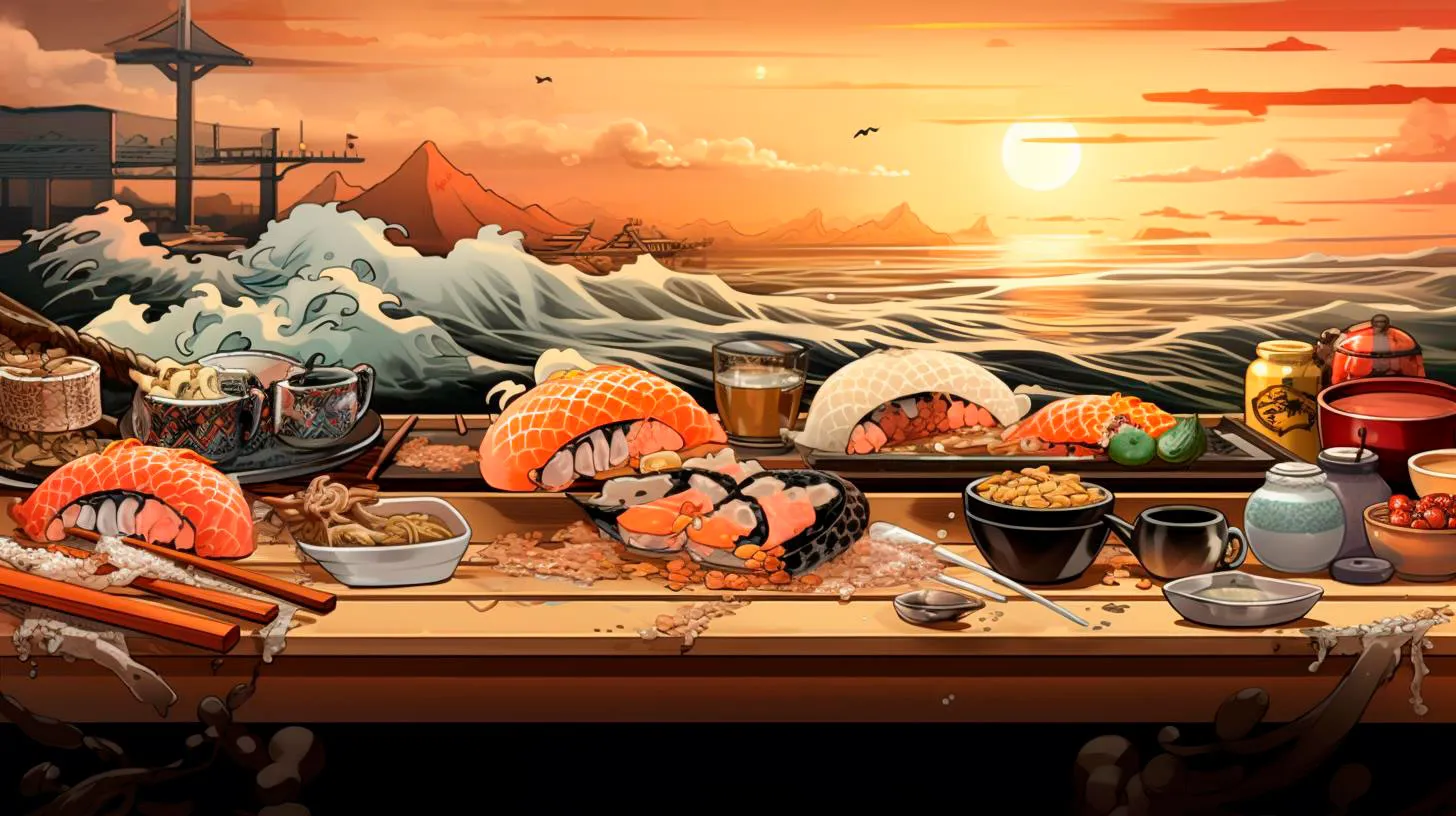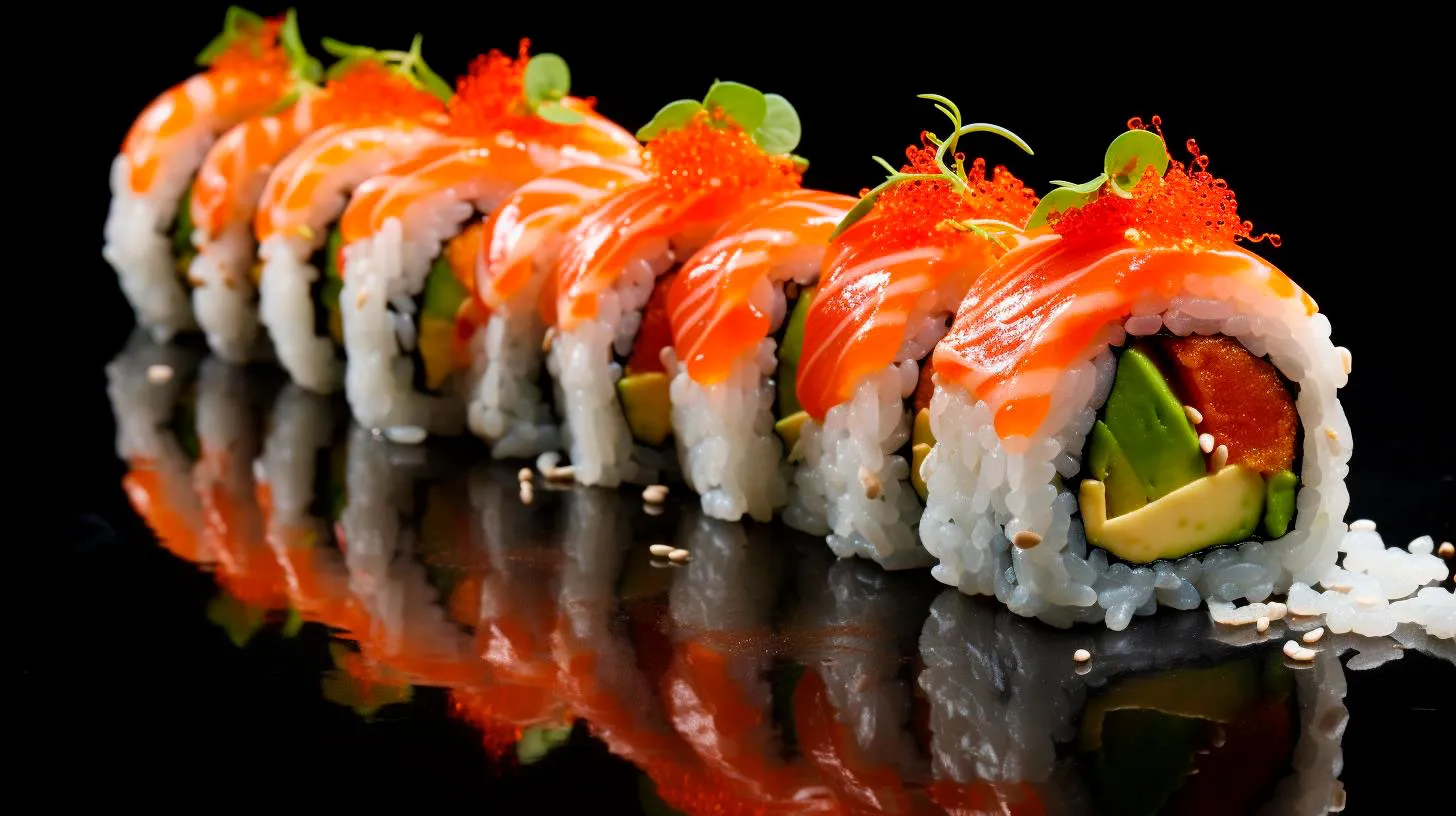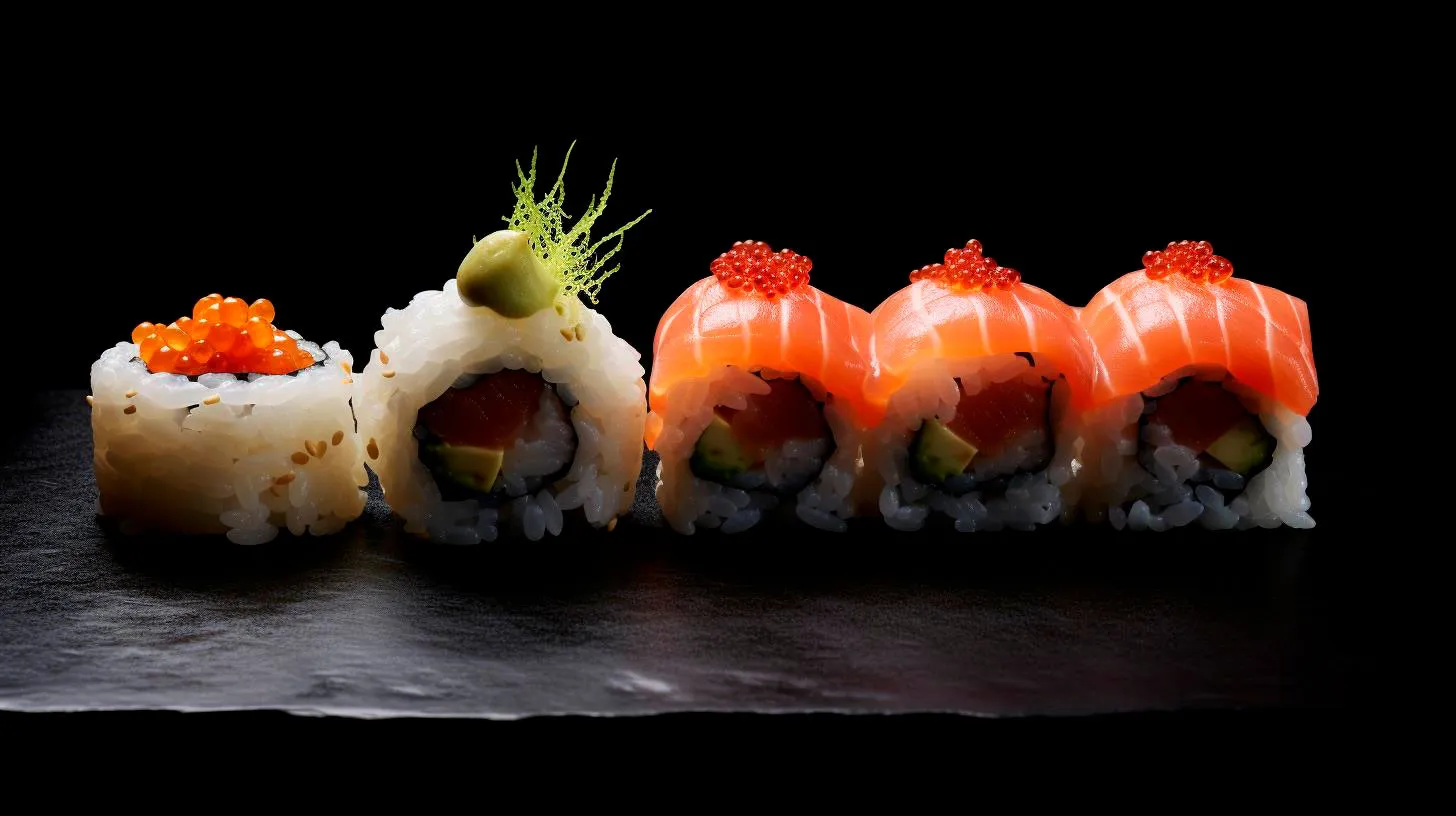From Fusion to Tradition: Global Influences on Sushi
In this article, we will delve into the global influences that have shaped sushi into the diverse and delectable cuisine it is today.
The Early Roots of Sushi
Before exploring the international impact on sushi, it is crucial to understand its humble beginnings in Japan. In its early days, sushi consisted of fermented fish wrapped in sour rice. It served as a preservation method, allowing people to store fish for extended periods. This traditional form of sushi, known as narezushi, was wildly different from the sushi we enjoy today.
Over time, a significant evolution occurred, transforming sushi from a preservation technique to an iconic Japanese dish that focuses on the harmony of flavors and presentation. This transformation opened doors to various culinary influences from different parts of the world.
The Entrance of Western Flavors
During the mid-19th century, Japan began opening its ports to the Western world, exposing its cuisine to new ingredients and cooking techniques. These foreign elements made their way into traditional sushi, shaping a newer, more modern style. Some notable influences include:
- Tempura: The introduction of tempura, a popular Japanese deep-frying technique, brought a delightful crispiness to sushi rolls. Today, tempura-based sushi rolls, such as shrimp tempura rolls, have become a staple in many sushi restaurants worldwide.
- Mayonnaise: The creamy richness of mayonnaise found its way into sushi thanks to Western influence. Sushi rolls like the California roll, filled with avocado, crab, and mayo, gained immense popularity and became an integral part of sushi menus globally.
- Spicy Tuna: A beloved choice among sushi enthusiasts, the flavorful combination of spicy tuna rolls was influenced by Western tastes. This fusion of creamy mayo, chili, and tuna brought a new dimension to traditional sushi.
Globalization and Sushi Innovation
The increasing popularity of sushi on a global scale led to further innovations and fusions. Chefs around the world began experimenting with local ingredients and flavors, creating mind-blowing sushi combinations. Let’s explore some of these global influences:
Latin Fusion with Nikkei Sushi
A fusion that blends Japanese techniques with Peruvian flavors, Nikkei cuisine has taken the sushi world by storm. The arrival of Japanese immigrants in Peru brought together diverse flavors, resulting in dishes like Tiradito sushi rolls. These rolls combine traditional sashimi with tangy Peruvian ceviche, creating a unique and refreshing sushi experience.
Hawaiian Twist with Poke Bowls
Poke bowls, originating from Hawaii, seamlessly integrate with sushi culture. Featuring marinated raw fish, rice, and a variety of toppings, poke bowls offer a perfect fusion of flavors. Their popularity has spread globally, highlighting the influence of Hawaiian cuisine on sushi.
Sushi Burgers: A Culinary Mashup
Combining the best of both worlds, sushi burgers have become a sensation in the culinary scene. These mouthwatering creations replace the traditional bun of a burger with sushi rice and fillings. The fusion of Japanese and Western flavors in the form of sushi burgers has caught the attention of food lovers around the globe.
Key Takeaways
The journey of sushi from a preservation technique to a global culinary phenomenon showcases its ability to adapt and evolve. As different cultures embraced sushi, they added their unique elements, flavors, and techniques. The key takeaways from the global influences on sushi are:
- Western flavors like tempura and mayo have become integral to sushi rolls, adding a new dimension to traditional Japanese cuisine.
- Nikkei sushi showcases the blend of Japanese and Peruvian flavors, creating a refreshing twist to classic sushi.
- Hawaiian poke bowls bring a taste of the islands to sushi, offering a fusion of raw fish and vibrant ingredients.
- Sushi burgers demonstrate the creativity of chefs, combining Japanese techniques with familiar Western burger elements.
With each passing year, sushi continues to evolve, accepting and embracing influences from all corners of the globe. Whether you prefer a traditional nigiri or an innovative sushi roll, the global influences on sushi ensure a diverse and exciting culinary experience.
Cultural Exchange: Sushi Chefs Go Global
This blog article explores the impact of cultural exchange on sushi chefs and the global reach of this iconic cuisine.
The Rise of Sushi’s Global Popularity
Sushi has witnessed a remarkable surge in popularity outside of Japan. In fact, sushi consumption is estimated to have doubled in the last decade in the United States alone. This rapid expansion can be attributed to a growing appreciation for healthy eating habits, international travel, and cultural curiosity. As people across the globe embrace sushi, the demand for authentic and diverse sushi experiences has soared.
Cultural Exchange and Its Influence on Sushi Chefs
Cultural exchange plays a crucial role in the journey of sushi chefs going global. Traditionally, sushi chefs in Japan undergo years of rigorous training to master the craft. However, in recent years, an increasing number of Japanese sushi chefs have ventured outside their native land to set up sushi bars or work in renowned establishments around the world. This exchange has not only allowed Japanese chefs to share their expertise with a wider audience but has also fostered a cross-pollination of culinary techniques and flavors.
- Sushi chefs from Japan bring the art of traditional sushi-making and its rich cultural heritage to their new environments.
- They introduce local ingredients and flavors to create unique fusion sushi dishes, appealing to varied palates.
- Cultural exchange stimulates creativity and innovation, leading to the birth of exciting new sushi trends such as sushi burritos and sushi cakes.
According to a survey conducted by the Japan Sushi Association, there are now over 45,000 sushi restaurants worldwide. This staggering number is a testament to the global influence of sushi chefs and the enduring cultural exchange that continues to shape the industry.
Advantages of Cultural Exchange for Sushi Chefs
The benefits of cultural exchange for sushi chefs extend beyond the realm of gastronomy. Here are some key advantages:
- Expanded Career Opportunities: Sushi chefs who travel and work overseas can expand their professional horizons and experience working in diverse culinary environments.
- Enhanced Skills and Techniques: Exposing oneself to different cooking styles and cultural norms can enrich a chef’s culinary repertoire, leading to increased expertise and innovation.
- Cross-Cultural Collaboration: Cultural exchange allows sushi chefs to collaborate with local chefs, exchanging knowledge and creating unique culinary fusions.
- Networking and Recognition: By showcasing their skills on a global platform, sushi chefs can gain international recognition, which can contribute to their personal and professional growth.
Such exposure not only benefits the sushi chefs individually but also contributes to the broader diversity and evolution of the global sushi scene.
Key Takeaways
Cultural exchange has propelled sushi’s popularity to new heights, transforming it from a niche cuisine to a global phenomenon. The migration of sushi chefs around the world has not only widened the availability of authentic sushi but also paved the way for fusion and innovation in sushi preparation. With increased cultural exchange, sushi enthusiasts can discover a diverse range of flavors and styles, embracing the evolution and creativity that cultural exchange brings.
In conclusion, sushi chefs going global through cultural exchange have undeniably played a vital role in the globalization of sushi. As sushi continues to conquer international taste buds, it serves as a delicious reminder of the interconnectivity and richness of cultures worldwide.
Exploring the World in a Bite: Global Fusion Sushi
Global fusion sushi combines the artistry of traditional sushi-making with creative ingredients from different cuisines. It’s a testament to the increasingly interconnected world we live in, where culinary traditions blend seamlessly and create unique dining experiences. Let’s dive deeper into the world of global fusion sushi and discover its key features, advantages, and takeaways.
Features of Global Fusion Sushi
- Fusion of Flavors: Global fusion sushi brings together flavors from various cuisines, resulting in explosive taste combinations. Imagine biting into a sushi roll that combines the umami of Japanese miso soup with the tangy spiciness of Mexican salsa.
- Unique Ingredient Combinations: Traditional sushi uses ingredients like raw fish, seaweed, and rice. However, with global fusion sushi, chefs get creative by incorporating ingredients such as avocados, mangoes, cream cheese, and even non-traditional proteins like chicken or tofu. This opens up a whole new world of possibilities.
- Diverse Presentation: While traditional sushi is often presented in simple, elegant arrangements, global fusion sushi embraces a more adventurous aesthetic. Sushi rolls may be garnished with colorful sauces, crispy tempura flakes, or exotic toppings like edible flowers or caviar.
Advantages of Global Fusion Sushi
Global fusion sushi offers several advantages that make it a must-try for adventurous foodies and sushi lovers alike:
- Expanded Flavor Palette: By incorporating ingredients from different cuisines, global fusion sushi expands the flavor palette beyond traditional sushi. This diversity allows for a wider range of taste experiences.
- Cultural Exchange: Global fusion sushi embodies the spirit of cultural exchange, bridging gaps between different culinary traditions. Each bite tells a story of different corners of the world coming together.
- Creativity Unleashed: Chefs have the freedom to experiment, resulting in unique sushi creations that defy expectations. The fusion of flavors and ingredients stimulates culinary creativity and opens new avenues for culinary exploration.
Key Takeaways
As you embark on your global fusion sushi adventure, keep these key takeaways in mind:
- Global fusion sushi combines flavors and ingredients from diverse cuisines, resulting in unique and exciting taste experiences.
- Traditional sushi ingredients are enhanced by innovative additions, such as avocados, mangoes, cream cheese, and non-traditional proteins.
- Presentation of global fusion sushi can be more adventurous and visually appealing than traditional sushi.
- Global fusion sushi expands the flavor palette, offering a wider range of taste experiences.
- It symbolizes the cultural exchange and unity of different culinary traditions.
- Chefs have the freedom to showcase their creativity, resulting in one-of-a-kind sushi creations.
So, the next time you crave sushi, dare to explore global fusion sushi for a truly extraordinary culinary adventure. With its diverse flavors, innovative ingredients, and artistic presentation, global fusion sushi introduces a new dimension to the world of sushi. Embrace the fusion and let your taste buds travel the globe, one bite at a time.
From East to West: Cultural Blending in Sushi Cuisine
In this article, we’ll explore the journey of sushi from its humble beginnings to its modern-day fusion with Western flavors.
The Origins of Sushi
Sushi has a rich history dating back to 8th century Japan, where it was originally a way of preserving fish in fermented rice. As time went by, sushi changed and adapted to reflect the various periods in Japanese history. Today, sushi has become synonymous with beautifully presented raw fish served on bite-sized portions of vinegared rice.
As Japanese immigrants began moving to different parts of the world in the late 19th century, they brought their culinary traditions with them. Sushi initially gained popularity among Japanese communities in the United States, particularly in cities with significant Japanese populations such as Los Angeles and San Francisco.
The Rise of Fusion Sushi
The blending of cultures is inevitable, and it was only a matter of time before sushi started incorporating flavors and ingredients from other cuisines. Enter “fusion sushi” – a style of sushi that combines traditional Japanese techniques with elements of other cuisines, creating unique and exciting flavor profiles.
One of the pioneers of fusion sushi is the American chef, Roy Yamaguchi, who introduced the concept of “Pacific Rim cuisine” in the 1980s. This approach combined Japanese flavors with local ingredients found in Hawaii, where he grew up. Today, fusion sushi has expanded to include influences from Latin American, Mediterranean, and even Indian cuisines.
The Advantages of Fusion Sushi
- Expands Flavor Options: Fusion sushi offers a wide range of flavors and combinations that cater to different palates. This allows sushi to be enjoyed by an even larger audience.
- Creative Presentation: Fusion sushi often showcases innovative presentation techniques, making the dining experience visually appealing and exciting.
- Local Sourcing: By incorporating local ingredients into the sushi-making process, fusion sushi supports local agriculture, creating a sustainable and eco-friendly dining experience.
- Increased Dietary Options: Fusion sushi provides options for those with dietary restrictions, such as vegetarian or gluten-free options, while still delivering a delicious dining experience.
- Cross-Cultural Appreciation: Fusion sushi promotes cultural exchange by introducing new flavors and culinary practices from different parts of the world.
Key Takeaways
Sushi has come a long way since its humble beginnings as a simple fish preservation method. Through the blending of cultures, it has evolved into a global cuisine that embraces creativity and innovation. So, next time you indulge in a sushi roll, remember the cultural journey it has undertaken to reach your dining table.
Sushi has become a universal favorite, crossing borders and gaining immense popularity around the globe. From traditional nigiri to elaborate fusion rolls, sushi continuously reinvents itself while staying true to its Japanese roots. The cultural blending in sushi cuisine beautifully reflects the diverse and dynamic nature of our interconnected world.



